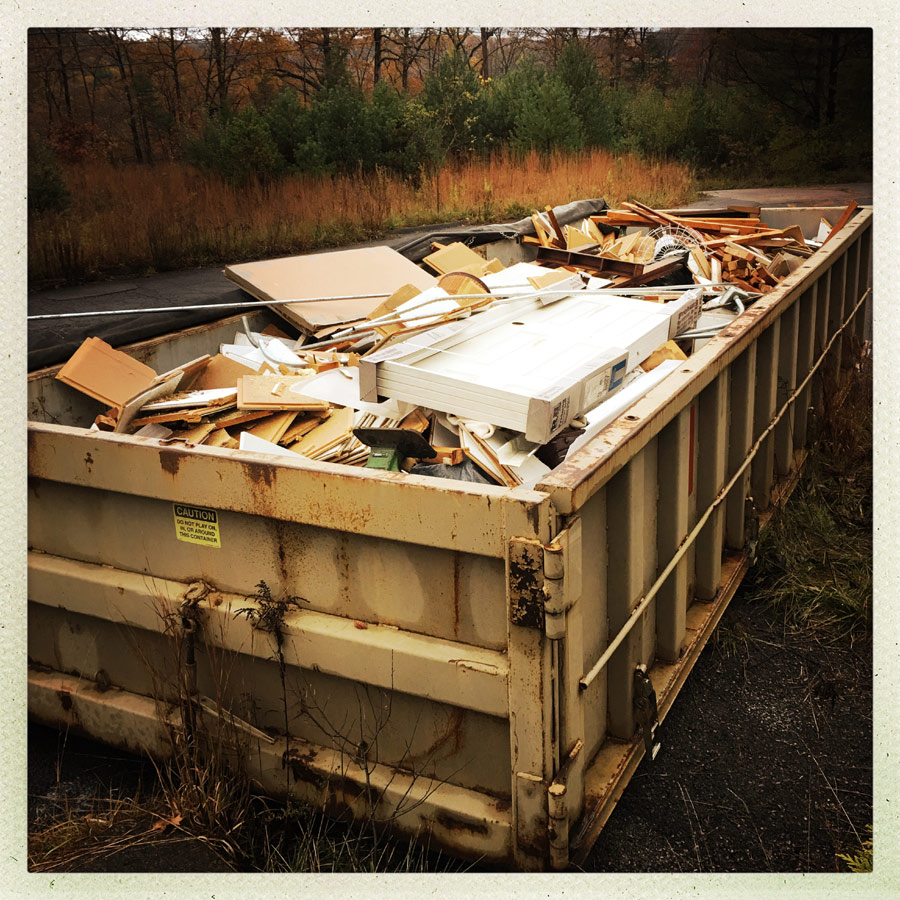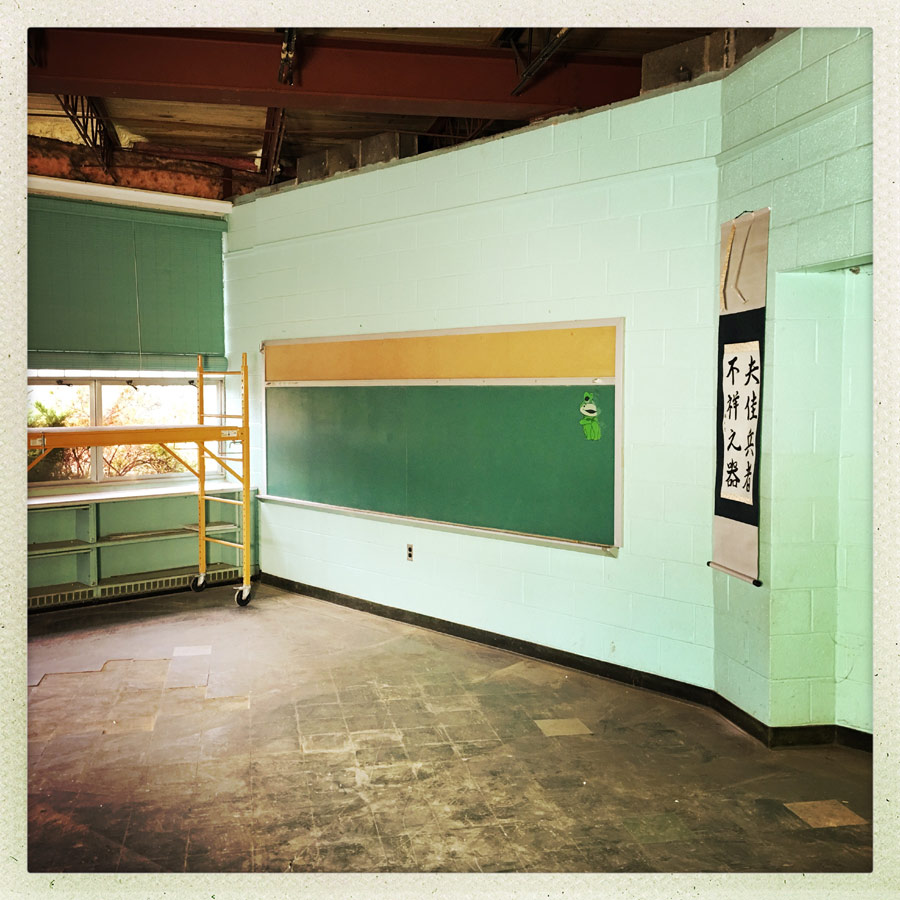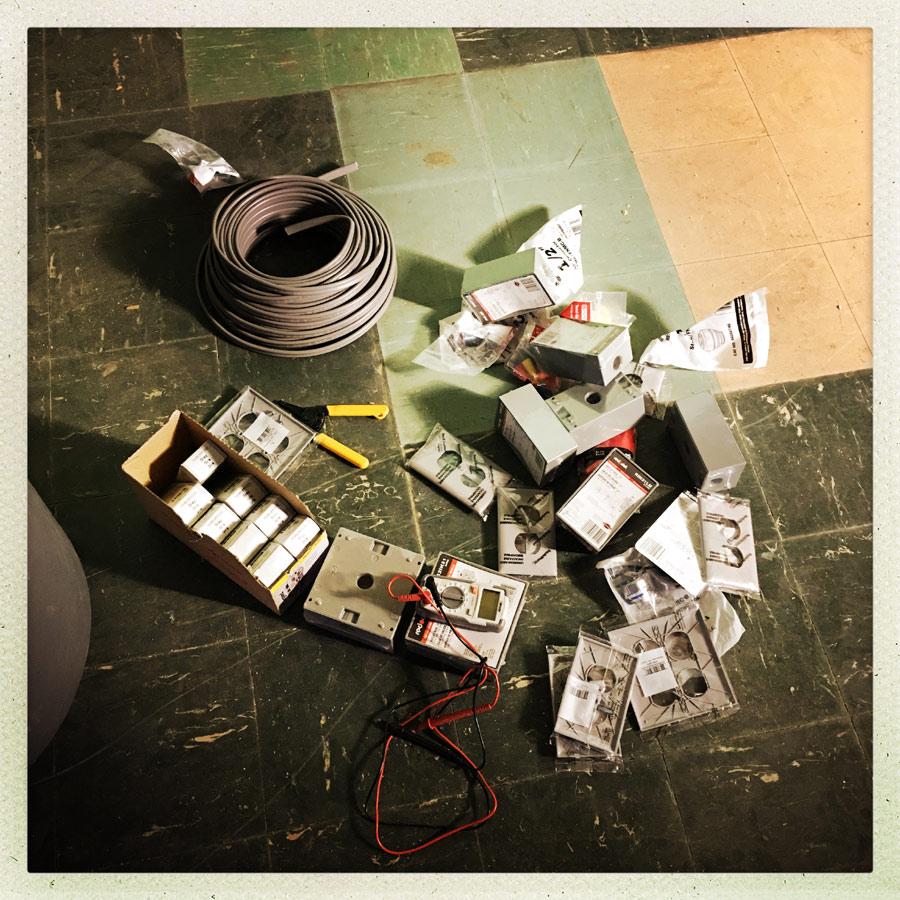Friday I finished pulling down the drop ceiling over at the studio.
In 1958 when they were inventing dropped ceilings, they did them differently. Nowadays they hang on recessed rails suspended by wires. You can take them down by just stacking the tiles, then snipping the wires and putting the rails away. In 1958, the tiles were stapled to 2x4s that some poor construction worker ripped lengthwise into 2x2s in order to save wood. The 2x2s are bolted through the support beams with washers, and nailed together. They don’t just come down.

Closing in on the end wall
To make it more fun, there’s conduit carrying power to the lights, which are all, also, bolted to the lattice of 2x2s. The first time I did one of these demolitions, I unbolted everything, unnailed it, and disassembled it carefully. It took me a week. This time, I used a great big sawz-all and made lengthwise passes across the room, shredding and destroying, then stopping to pick up the pieces and haul them to the dumpster. Because of the layout of the building, that meant filling the garbage can (illustrated) and carrying it 100yd and down some stairs to the dumpster. It’s all good: I need the exercise.

Dumpster 2.0
The 2x2s make up a lot of volume, as do the tiles. This is actually the second dumpster I filled. Since I had a dumpster, I thought, “why not get rid of some stuff?” which meant it was time to purge my old theatrical flats, construction materials, broken machinery, computers from the 1990s, and whatnot.
I’m a packrat. You probably figured that out. But I’m a “high functioning packrat” – I don’t keep most of it at home (well, except the basement…) – I keep it in my extended 5,500sf closet 10 miles from home.

The way they ran the electricity was odd, too. the main power for each room comes in through conduits in the concrete slab (I bet that’s a doozie to fix!) and up into switch-boxes, then conduits up to the ceiling. But the builders used individually stranded wires, no grounds, and ran them in ways I still do not understand. Normally, you’d pull circuits to the switch panel and use the switches to interrupt the circuit to the mains. For some of the light circuits, they ran the power to the light, then made a loop back to the switch box to interrupt the circuit – it’s the same principle as a giraffe’s Phrenic Nerve. I.e.: it’s a relic of evolution.
I was reminded of this when I used the sawz-all to chop one of the conduits, and there was current running through it, even though all the light switches were off. For the rest of the power, I dissected it carefully, pretending I was defusing a bomb (the circuit breakers are old enough that I don’t want to trip them and have to try to identify them and un-trip them).
Once the ceiling is down, it’s pretty nice up there. Some signs of leaking where the roof leaked for about a decade, but the wood is all right. There is an air-space across the entire top of the building, which will help diffuse the heat when the forge is running. I expect the forge will also help dry the whole building out: win, win, win.
By the end of the 3rd day of chopping, unbolting, and hauling, I had the room broom clean. It’s an incredibly satisfying feeling.

looking west
The old schoolhouse is packrat heaven (did I mention that I am a packrat?) Each classroom has a large walk-in storage closet, a small storage closet, and the outside of the room is metal shelves that also house the copper pipe and fin radiator system. It’s a really nice design, except the 1958 furnaces are doubtless incredibly inefficient, and the pipes are probably burst from freezing.
Those storage shelves are going to be so nice! I’ll use one for metal bars, one for abrasives, one for drinks, one for… etc. The big windows can unlatch and drop out, and I chose the westward-facing room because that’s where the prevailing breeze comes from. I won’t have to worry about suffocating (though I will set up at least 2 CO alarms).
There, and to the left are where I am going to build the benches for the grinder(s), metal cutting bandsaw, vices, and who knows what else. I expect I’ll build the benches next week, once I have the electrical system up and running so that I can use the metal cutting bandsaw to chop up the conduit I’ll be using as a bench-frame. One of the things I love about projects is getting everything done in the right order – my brain just automatically does that and it’s pretty good at it. Actually, it’s better than “pretty good” it may be “world class.” It sure comes in handy.

looking north
That’s where the forge, anvil (need to make a stand) and press will go. I’m going to leave the blackboard up to deflect heat off the wall.
The hanging scroll is by a friend’s wife, who is a Japanese calligraphy master. Occasionally I have an idea for a “scroll that must be done” and commission them to do it. I’m never in a hurry. This one, she started studying for last year, when I asked about it, and by some quirk of fate, he mounted it up in perfect colors to match the wall. I am going to have it there to remind me of an important thing:
The weapons of war are unfortunate instruments. – Lao Tze
I will probably make some weapons, eventually, but I intend to avoid producing “tactical” instruments; they are the most unfortunate of all.
You can’t see them from these angles, but I’ve also installed other important things: two fire extinguishers, a first aid kit, and a rack for brooms and dustpans. There is another blackboard/bulletin board on the other side of the room and I am going to make some blade-racks to mount on the upper part, and will thumbtack ideas and notes on the corkboard.

It won’t install itself.
Next up is electricity. Today I carefully dissected the entire power system and cleaned up all the wires. I’m going to need more gang-boxes for outlets, and new switches, and a few things but now that the old wiring is out, I ought to be able to string this pretty quickly and then power down the whole building, hook it up, and see what happens when I power it up.

Every time I go to buy wire, I am shocked anew at the cost of copper wire. The breakers in the panels are 20amp, so I am using heavy wire, and it’s $1/foot – that hundred foot roll was $110.
I got a bunch of hanging flourescent shop lights and I plan to hang them low on chains, so it looks like some kind of gothic dungeon in there. I did a similar trick in my photography studio: I put gang boxes on the ceiling and then hung LED spotlights in aluminum work-light fixtures, so there are little sharp pools of light and big areas of darkness. It makes the room look much bigger and gothier: win, win. I will have another switched circuit that controls LED studio spotlights on specific work-areas where I may want to shoot video.

Wicked.
And oh yes the old fiber tile ceilings. Actually, someone mounted drop ceiling panels in a friend’s garage (c. 1998) by nailing them up. It was a lot of fun trying not to destroy them while pulling a bunch down to do work.
I’m gonna die of jealousy – all that light! The built in shelves!
You’ve done a great job, going to be a grand forge.
There is something weird about the formatting of this page.
F [i’m not here, i’m gone]@#1:
Actually, someone mounted drop ceiling panels in a friend’s garage (c. 1998) by nailing them up. It was a lot of fun trying not to destroy them while pulling a bunch down to do work.
The nailed-up ones are horrible. I really felt sorry for whoever stapled these up. It must have been a ton of work.
I should have mentioned the mouse poops. Mice appear to really love drop ceilings. Think about it – it’s safe, invisible, and it allows them to run the entire building without being exposed. The whole ceiling has a thin scattering of poops.
Yes, the formatting is all screwed up. Don’t know why.
Caine@#2:
I’m gonna die of jealousy – all that light! The built in shelves!
I’m super lucky. When I first found the place, I ran around muttering “it’s perfect… it’s perfect…” Then when I found out how little they wanted for it, I was over the moon.
chigau@#3:
There is something weird about the formatting of this page.
I have no idea. I didn’t do anything different. It’s probably the wordpress “random formatting what you see is what you hope to get” feature.
Edit: Aha, it appears that I must have (at some point) hit a bullet item, which put the whole page into a list-item format. WordPress is pretty good about trying to reverse mark-up when you unset it but sometimes it fails. In this case, the whole article was left in the list item frame. Yay for HTML edit mode!
I’m with Caine here… and those blinds go up HIGHER? For even MORE light?! Not to mention it’s a west-facing window… wow. Just, wow. Amazing.
As far as mouse poop: I hope you were wearing a really good mask… I don’t know about your area, but in this one? We’ve had far too many cases of Hanta virus due to mouse poop and people cleaning up things without a mask.
You’re going to have an incredibly comfortable and well-lit forge. Have you thought of any names for it?
kestrel@#8:
I’m with Caine here… and those blinds go up HIGHER? For even MORE light?! Not to mention it’s a west-facing window… wow. Just, wow. Amazing.
It’s glass block all the way up the wall.
When I get fully kitted I will probably put reflective foil on the clear glass. I don’t want people walking by and looking in the window and going “oo0! MIG welder!” I have a security system but it doesn’t help much except it gives me pictures of people and makes loud noises. I’ve been meaning to put a relay on the alarm so it’ll fire off the air raid siren on the roof. Yes, I have an air raid siren. I should probably sell it: “tactical air raid siren”
As far as mouse poop: I hope you were wearing a really good mask…
Yeah, I thought of that after the job was done. I appear to be OK. One thing that is nice about isolated buildings – it has its own population.
You’re going to have an incredibly comfortable and well-lit forge. Have you thought of any names for it?
I am thinking of it as “badger’s forge” but I do own the domain “unfortunateinstruments.com” – I was planning on using that as a podcast on military history, but I wound up blogging here instead.
I believe that putting the effort into making your work-space nice and clean and well-laid out, results in better work. So I’m hoping I can get this place so nicely set up that all I have to do is sit in an armchair and watch the metal hammer itself.
Marcus, you play Minecraft better than ANYONE.
I wouldn’t be a bit surprised if you got a visit from the local gendarmes one of these days. That building would be a fine candidate for a growing facility for certain flora with medicinal properties. Somebody’s sure to notice the increased activity and power usage.
For some of the light circuits, they ran the power to the light, then made a loop back to the switch box to interrupt the circuit – it’s the same principle as a giraffe’s Phrenic Nerve. I.e.: it’s a relic of evolution.
They do it this way in the UK, even in new builds.
It makes wiring easier: you need only one cable (two wires plus earth, because these days all circuits must have an earth connection, even lighting circuits) going to the switch, compared to three if you made the connections in the switch boxes (supply in, supply out to the next room, and switched power to the light). It’s easier to run cables in the loft and along/through the joists between floors, than inside walls (which tend to be solid brick or cement blocks), so they keep that to a minimum. It’s even easier because standard British light fittings come with all the terminals to wire supply in, supply out, the switch, and the light itself, all in a neat junction box poetically called a ceiling rose, from which hangs a pendant (cable plus light holder).
Now if your walls are all studwork, it makes very little difference how you do it, and you may prefer to have the connections easily accessible in the switch boxes rather than in the ceilings; but for masonry walls it makes perfect sense to do it the British way. There’s even a third way, used in places prone to earthquakes, where buildings tend to be all reinforced concrete: they run the wires near the top of the walls, in conduits buried into the concrete, with junction boxes in the walls, and single cables to both the switch and the light fitting. This allows them to use very small conduits, because there’s only one cable in each. Good luck making alterations to that system, though.
Does owning and using a forge make you guilty of forgery?
Lofty@#13:
Only if I use it to steel.
DonDueed@#11:
I wouldn’t be a bit surprised if you got a visit from the local gendarmes one of these days. That building would be a fine candidate for a growing facility for certain flora with medicinal properties. Somebody’s sure to notice the increased activity and power usage.
The place was broken into in 2008, and the state police gave it a very thorough sniffing-over. They were particularly interested in the chemical vault so I gave them a tour of that, which will probably keep them from ever wanting to visit the building again. “Here, officer, here’s a breath mask you can wear… ” I figured as soon as they saw a safety orange steel locked cabinet, they’d assume I was making meth. So I hammed it up, “I don’t know what they use to make meth, but it can’t be as bad as this stuff…” I keep some emails from my former site safety officer at Fisher Scientific, in case. [wet plate chemistr’s most notable components: ether, ethanol, glacial acetic acid, nitric acid, silver nitrate, cadmium bromide, potassium cyanide, nitrocellulose.]
You know, I’m thinking that a plasma cutter has a very different usage profile from a grow room. Detecting that ought to be a pretty simple matter of system log analysis. Except the US “smart grid” is … not very smart.
I pretend to be friendly with them any time they come by.
However, I actually have been known to plant the occasional smokable. Not for my own consumption; I had a friend who’d hang out on my porch and sometimes picked seeds out and tossed them away. I asked for them and planted them in the flower pots outside the county courthouse and the police barracks. They have a great big “ten commandments” plaque and a 9/11 memorial (nobody from Clearfield died on 9/11, it’s just jingoism) also with flower pots. I’m a “giving” sort of guy like that. I was hugely bummed last year because we had a freak frost that killed all the amsterdam blue poppies just as the seeds were germinating. They would have brightened the american legion park up a lot; there is a big Sherman tank in the middle that I thought would look so nice surrounded by pretty blossoms of dreams. Besides, I hear there’s an opiate emergency.
cvoinescu@#12:
It makes wiring easier: you need only one cable (two wires plus earth, because these days all circuits must have an earth connection, even lighting circuits) going to the switch, compared to three if you made the connections in the switch boxes (supply in, supply out to the next room, and switched power to the light).
Yeah, I wonder if they’ll go back to it because of the cost of copper.
I seriously underestimated the amount of wire I want to run. It’s going to drive me nuts if I don’t have all the outlets I want where I want them, and since my memory is getting worse, I want to have the power for all the bench-mounted machines and the forge fan, etc, all switchable at the door, so I don’t have to wander around making sure everything is off.
abbeycadabra@#10:
Marcus, you play Minecraft better than ANYONE.
I have avoided that game like the plague. Like I used to avoid World of Warcraft.
I know how I operate. Back in ’09 a friend talked me into dipping my toe into World of Warcraft and those three years are the lost years. Minecraft … (shudder)
abbeycadabra@#10:
Marcus, you play Minecraft better than ANYONE.
Darned LARPers.
#17, #18
Tee hee.
I do play it, and the main draw to me is being able to express, sadly virtually, the sort of serious Build And Make urges that an urban pleb can never access. I am deeply jealous of this building and have been left with an abiding desire to go visit Marcus just to help work on it.